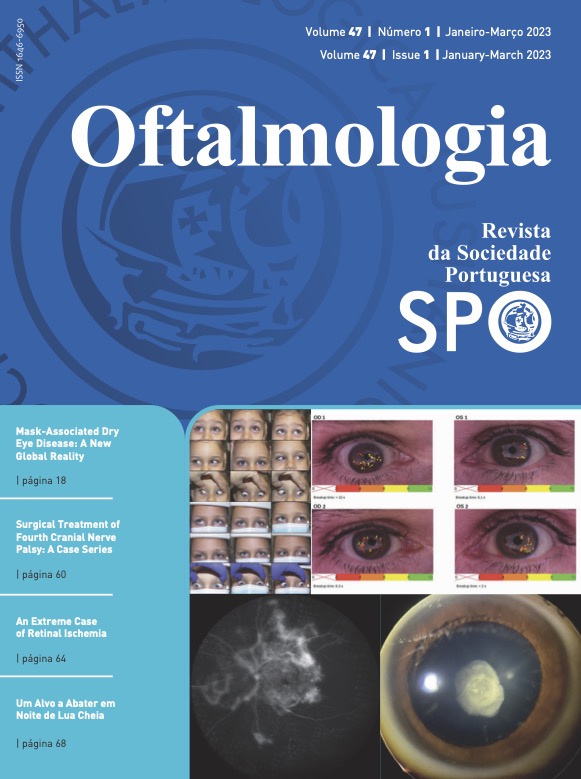Mask-Associated Dry Eye Disease: A New Global Reality
DOI:
https://doi.org/10.48560/rspo.28270Keywords:
Dry Eye Syndromes, Health Personnel, Respiratory Protective Devices, COVID-19Abstract
INTRODUCTION: The COVID-19 pandemic introduced significant changes in our daily habits, including the widespread use of face masks. Numerous reports pointed to an increase in perceived dry eye symptoms, due to an unnatural airflow towards the ocular surface during expiration.
The purpose of this work was to assess the change in dry eye symptoms in healthcare profes- sionals with the frequent use of face masks and to measure the effect of a half-workday period of mask wearing in noninvasive ocular surface parameters.
METHODS: Ocular Surface Disease Index (OSDI) questionnaire was used to assess symp- toms of dry eye disease. In each answer, the participants were asked to self-report the symptoms before and after the generalized use of face masks. In addition, all volunteers underwent a nonin- vasive ocular surface workup by means of TearCheck® (ESW Vision, Linz, Austria) in the same day at 2 different time points: 1 - in the beginning of the work shift before wearing face mask; 2 - after 6 hours of continuous face mask use. Eye redness score (range 1-4), non-invasive break-up time (NIBUT), tear meniscus thickness and tear film stability evaluation (TFSE®) variation between the two measurements was calculated.
RESULTS: Forty eyes from 20 subjects were included. A percentage of 80% (n=16) of the par- ticipants were female and the mean age of the sample was 47.15 ± 12.99 years old. A mean increase in the OSDI score of 15.33 ± 10.80 points was noted when comparing the pre- and the COVID-19 periods (p<0.001***). Concerning the ocular surface parameters, the following evolution was ob- served after 6 hours of face mask use: eye redness score increased 0.75 ± 0.74 points (p<0.001***); tear meniscus thickness decreased 0.04 ± 0.13 mm (p=0.034*); and NIBUT reduced 2.20 ± 3.82 s (p=0.007**). A non-significant increase in TFSE® of 45.11 ± 212.26 points was also noticed (p=0.211).
CONCLUSION: We report a clear increase in dry eye symptoms and signs associated with the use of face masks. Ophthalmologists should advise their patients of the potential ocular sur- face health risks related to face masks, and fitting strategies should be adopted to minimize the discomfort associated with this condition.
Downloads
References
Ayaki M, Tachi N, Hashimoto Y, Kawashima M, Tsubota K, Negishi K. Diurnal variation of human tear meniscus volume measured with tear strip meniscometry self-exam-ination. PLoS One. 2019;14:e0215922. doi: 10.1371/journal. pone.0215922.
Boccardo L. Self-reported symptoms of mask-associated dry eye: A survey study of 3,605 people. Cont Lens Anterior Eye. 2022;45:101408. doi: 10.1016/j.clae.2021.01.003.
D’Souza S, Vaidya T, Nair AP, Shetty R, Kumar NR, Bisht A, et al. Altered Ocular Surface Health Status and Tear Film Im- mune Profile Due to Prolonged Daily Mask Wear in Health Care Workers. Biomedicines. 2022;10: 1160. doi: 10.3390/bio- medicines10051160.
Esen Baris M, Guven Yilmaz S, Palamar M. Impact of pro- longed face mask wearing on tear break-up time and dry eye symptoms in health care professionals. Int Ophthalmol. 2022;42:2141-4. doi: 10.1007/s10792-022-02213-9.
ESW Vision. How to interpret tearcheck® examinations: In- terpretation Guide v3 01-2022. Linz: ESW Vision; 2022.
Fan Q, Liang M, Kong W, Zhang W, Wang H, Chu J, et al. Wearing face masks and possibility for dry eye during the COVID-19 pandemic. Sci Rep. 2022;12:6214. doi: 10.1038/ s41598-022-07724-0.
Giannaccare G, Pellegrini M, Borselli M, Senni C, Bruno A, Scorcia V. Diurnal changes of noninvasive parameters of oc- ular surface in healthy subjects before and after continuous face mask wearing during the COVID-19 pandemic. Sci Rep. 2022;12:12998. doi: 10.1038/s41598-022-17486-4.
Jahanbani-Ardakani H, Hosseini M, Almasi S, Khalili MR. Letter to the Editor: Face Mask-associated Dry Eye in Health Care Professionals amid the COVID-19 Pandemic. Optom Vis Sci. 2021;98:995-6. doi: 10.1097/OPX.0000000000001758.
Kapelushnik N, Benyosef S, Skaat A, Abdelkader A, Landau Prat D, Blum-Meirovitch S, et al. The effect of face masks dur- ing COVID-19 pandemic on ocular surface temperature-a clinical thermographic analysis. Diagnostics. 2022;12 :1431. doi: 10.3390/diagnostics12061431.
Krolo I, Blazeka M, Merdzo I, Vrtar I, Sabol I, Petric-Vickovic I. Mask-associated dry eye during COVID-19 pandemic-how face masks contribute to dry eye disease symptoms. Med Arch. 2021;75:144-8. doi: 10.5455/medarh.2021.75.144-148.
Moshirfar M, West WB, Jr., Marx DP. Face mask-associated ocular irritation and dryness. Ophthalmol Ther. 2020;9:397- 400. doi: 10.1007/s40123-020-00282-6.
Nair S, Kaur M, Sah R, Titiyal JS. Impact of taping the up- per mask edge on ocular surface stability and dry eye symp- toms. Am J Ophthalmol. 2022;238:128-33. doi: 10.1016/j. ajo.2022.01.006.
Scalinci SZ, Pacella E, Battagliola ET. Prolonged face mask use might worsen dry eye symptoms. Indian J Ophthalmol. 2021;69:1508-10. doi: 10.4103/ijo.IJO_2641_20.
Shalaby HS, Eldesouky MEE. Effect of facemasks on the tear film during the COVID-19 pandemic. Eur J Ophthalmol. 2022:11206721221110010. doi: 10.1177/11206721221110010.
Wang C, Horby PW, Hayden FG, Gao GF. A novel coronavi- rus outbreak of global health concern. Lancet. 2020;395:470-3.
Downloads
Published
How to Cite
Issue
Section
License
Copyright (c) 2023 Revista Sociedade Portuguesa de Oftalmologia

This work is licensed under a Creative Commons Attribution-NonCommercial 4.0 International License.
Do not forget to download the Authorship responsibility statement/Authorization for Publication and Conflict of Interest.
The article can only be submitted with these two documents.
To obtain the Authorship responsibility statement/Authorization for Publication file, click here.
To obtain the Conflict of Interest file (ICMJE template), click here





